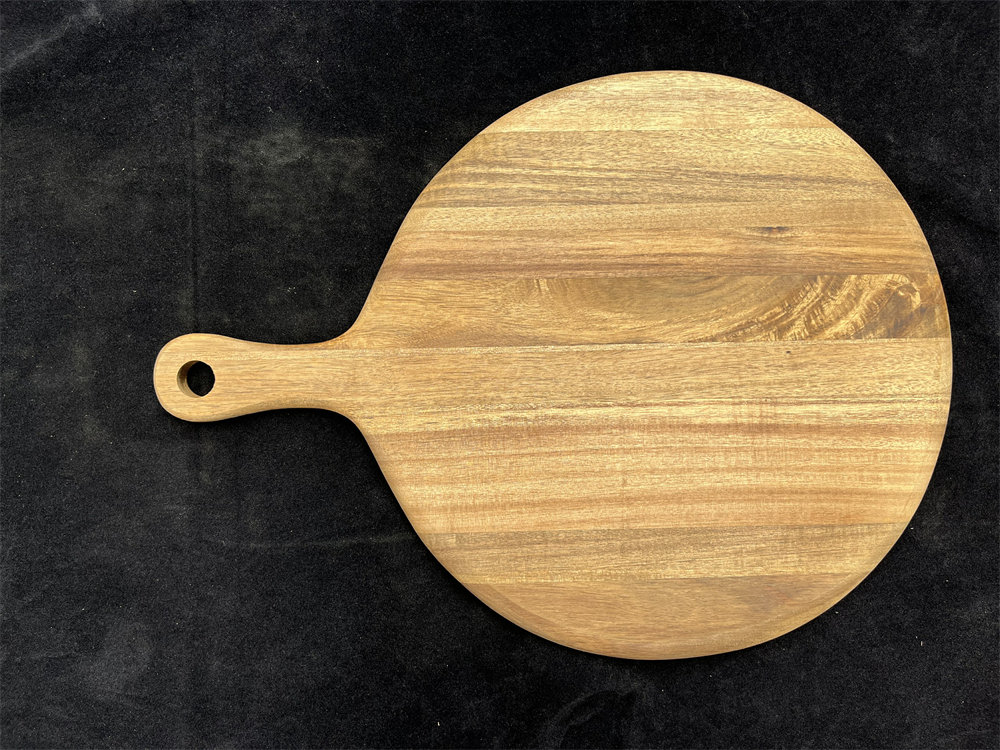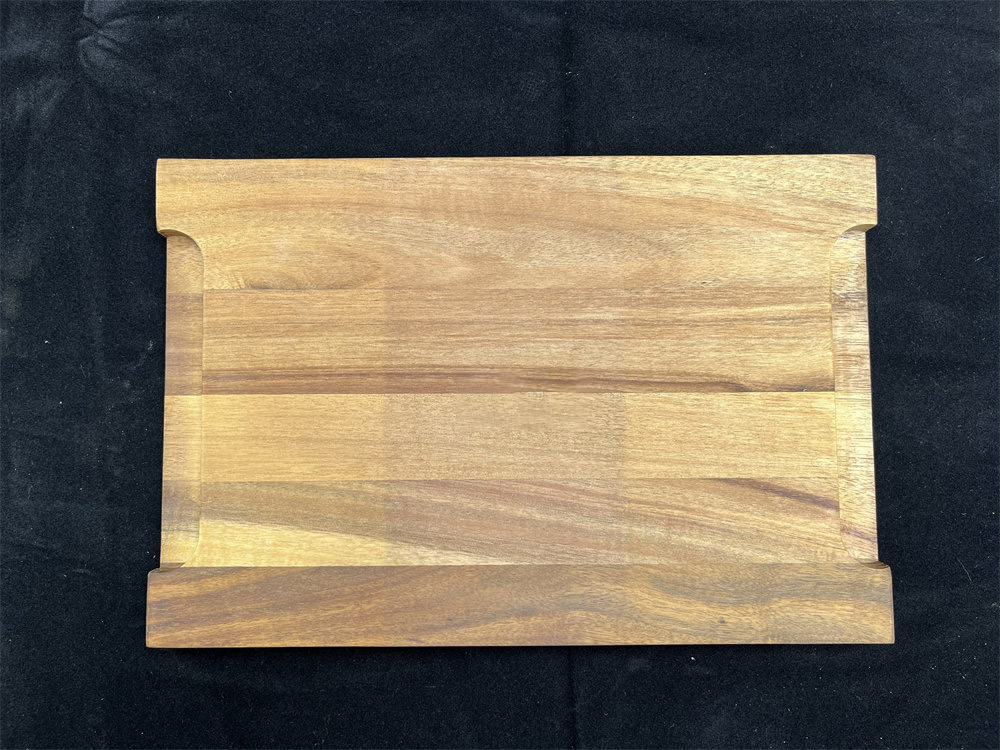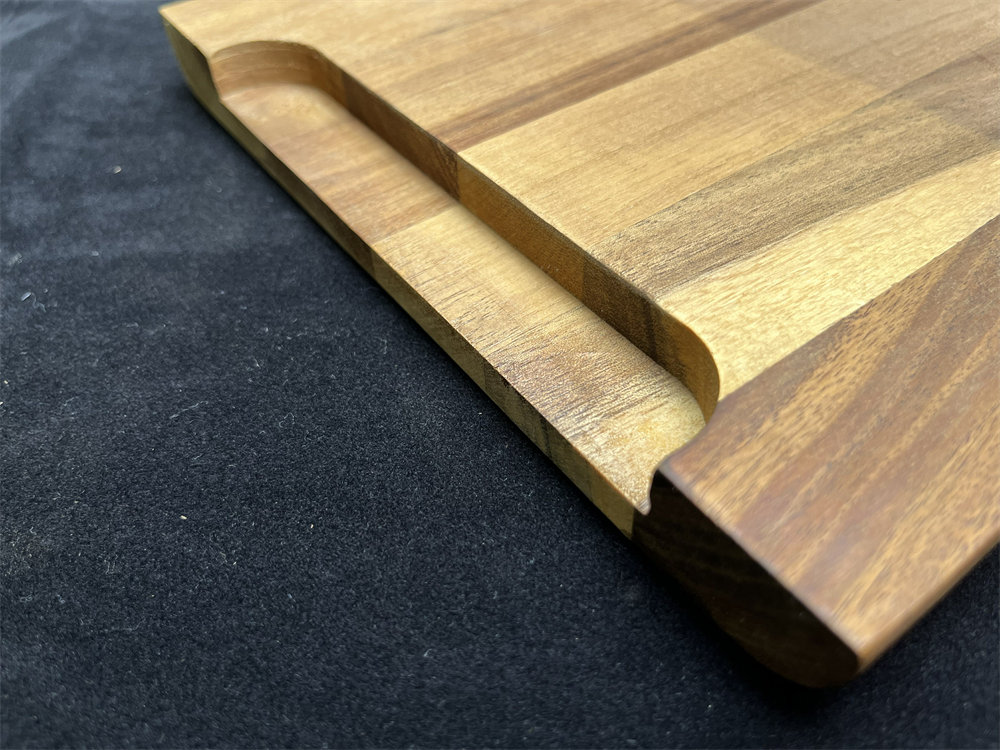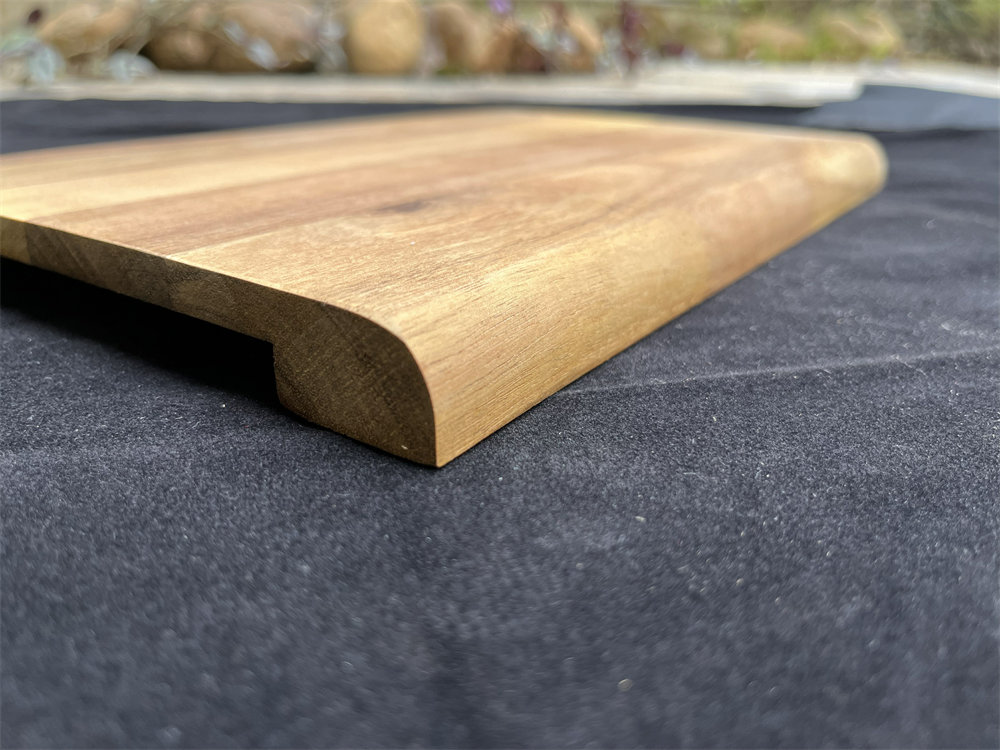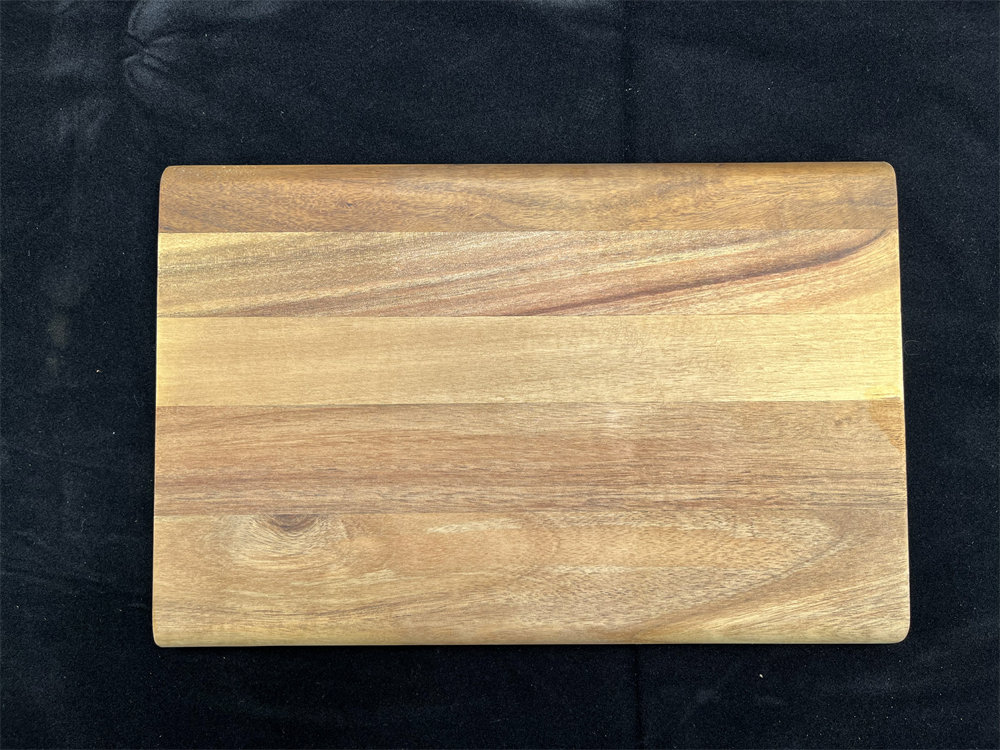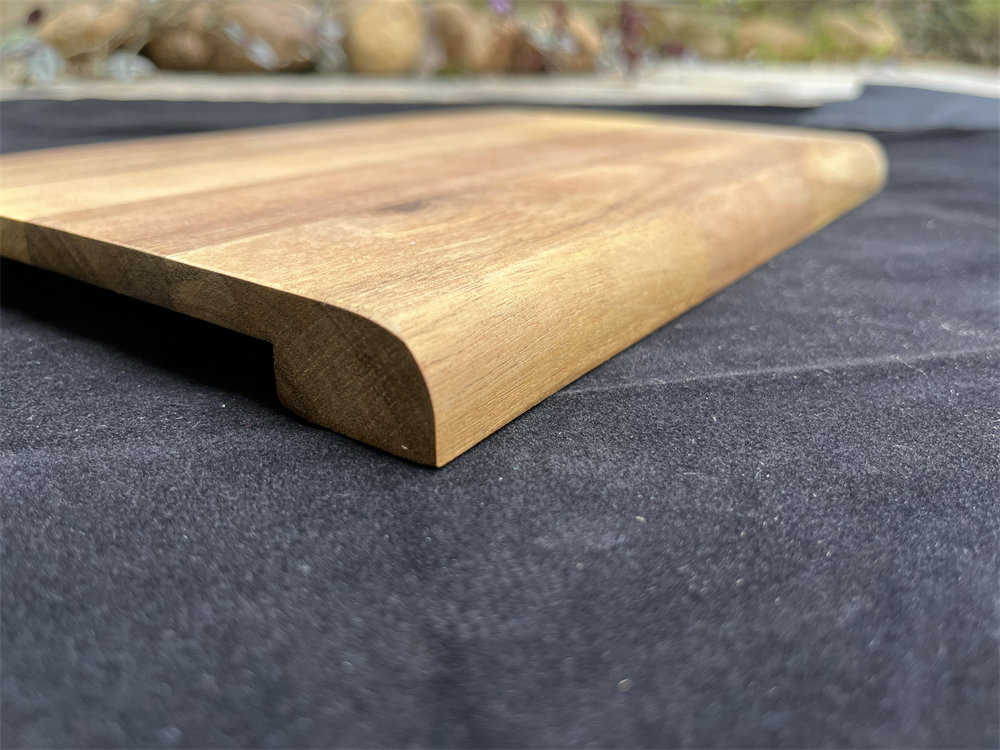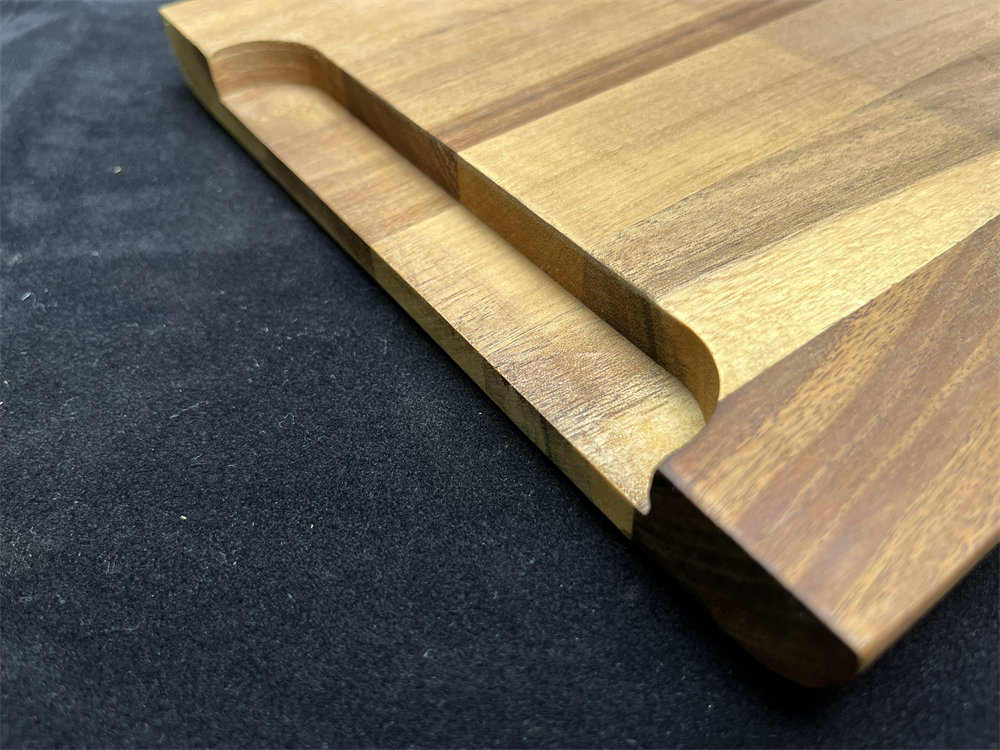Wood Cheese Cutting Board
- Product Information
Wood Cheese Cutting Board is a cheese cutting board made of acacia wood, with a rectangular shape and rounded and finely processed edges. Its surface is protected by food-grade paint or cooking oil, showing the natural texture and color of acacia wood. This cheese cutting board not only has practical cutting functions, but also is a kitchen decoration full of natural beauty, adding a sense of atmosphere to the user's cooking and dining experience.
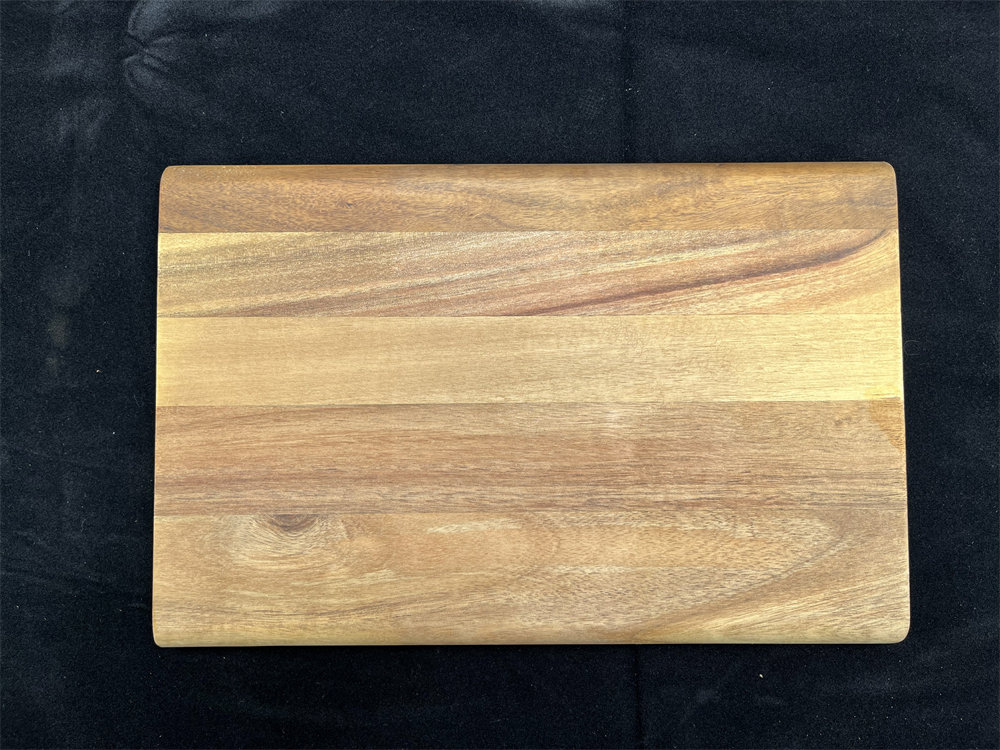
Wood Cheese Cutting Board Specifications:
| Model Number: | XYL-WCB001 |
| Product name: | Acacia wood cutting board |
| Material: | Acacia wood |
| Surface finish: | Lacquer or edible grade oil |
| Shape: | Rectangle |
| Size: | 30x20x2cm |
| Color: | Natural |
| Packing: | Poly bag + inner box + export carton |
| Place of Origin: | Guangdong China |
| MOQ: | 300 SETS |
| Lead time: | 30-35 Days |
| Shipping way: | Sea shipment, air shipment or express |
| Factory Nature: | China Manufacturers Suppliers Factory |
Features of Wood Cheese Cutting Board:
1. Precise size design
The size of the cutting board is 30 cm × 20 cm × 2 cm. This size design was determined after sufficient market research and user feedback. The 30 cm length and 20 cm width provide a spacious and practical cutting and display space, which can easily accommodate a variety of cheeses and snacks. At the same time, the 2 cm thickness ensures the stability and durability of the cutting board, so that it will not easily shake or deform during the cutting process. User surveys show that about 92% of household users believe that cutting boards of this size are very suitable in actual use and can meet the needs of daily cheese cutting and display. In addition, cutting boards of this size are also easy to clean and store. They can be easily put into the sink of most households and cleaned. At the same time, the storage space occupied is reasonable and will not bring too much burden to the kitchen.
2. High-quality acacia wood material
The cutting board is made of acacia wood as the main material. Acacia wood is a hard and durable wood with a density of about 0.6 - 0.7 g/cm3 and a hardness of 1400 - 1600 lbf (according to the Janka hardness test standard). These characteristics enable the acacia wood cutting board to withstand frequent cutting and friction from knives, ensuring that the surface condition remains good after long-term use. Compared with common pine or other softwood materials, acacia wood has a longer service life, better wear resistance, and is not prone to knife marks and scratches. Professional tests show that after 6 months of use in a simulated home kitchen environment, the surface wear of the acacia wood cutting board is only 3% - 5%, while the wear of ordinary pine cutting boards is as high as 12% - 15%. The high density and hardness of acacia wood make it an ideal choice for making cheese cutting boards.
3. Rectangular shape design
The cutting board is designed in a rectangular shape, which is not only beautiful and generous, but also highly practical and functional. The rectangular shape makes the cutting board more stable during placement and use, and it will not roll or tilt as easily as a circular or irregular shaped cutting board. The length-to-width ratio of the cutting board is 3:2, which is a ratio derived from ergonomic research and can best adapt to the grip and operation habits of human hands. In actual use, this ratio of cutting boards can provide users with a more comfortable use experience and reduce hand fatigue. In actual use, rectangular cutting boards can make full use of space and facilitate users to perform multiple operations such as cutting, placement and display. User surveys show that about 90% of users believe that rectangular cutting boards have excellent stability and ease of operation, and work efficiency is increased by 20% - 30% compared to cutting boards of other shapes.
4. Fine surface grinding
The surface of the cutting board has undergone multiple fine grinding processes, and the smoothness reaches the international standard level 15 - 18. Use high-precision sandpaper for grinding to ensure that there are no obvious burrs or unevenness on the surface. Professional test results show that the average surface roughness is 0.8 - 1.2 microns, which is much lower than the industry standard of 2.0 microns. This fine surface treatment not only improves the beauty and touch of the cutting board, but also facilitates cleaning and maintenance. After cutting cheese or other food, residues and stains can be easily wiped clean with a damp cloth, leaving no dead corners for cleaning, effectively preventing bacteria from growing and keeping the cutting board hygienic and clean. For example, in home use, after a simple wipe, the cleaning rate of cheese residue on the surface of the cutting board reaches more than 95%, which is significantly higher than that of the cutting board with a rough surface.
5. Food safety certification
The surface treatment of the cutting board uses food-grade oil or food-grade paint, which meets strict FDA standards and EU Food Contact Materials Regulation (EU) No 1935/2004. The main component of food-grade oil is natural vegetable oil, which is non-toxic and harmless and will not cause any health risks to the human body. After professional testing, its heavy metal content is far below the safety limit, for example, the lead content is less than 0.1 ppm, far below the safety limit of 10 ppm, and the mercury content is less than 0.01 ppm, far below the safety limit of 0.5 ppm. This ensures that the cutting board will not release harmful substances when in direct contact with food, ensuring the health and safety of users. It is especially suitable for placing foods that are directly ingested, such as cheese, meat and fruit. In the simulation test of a professional laboratory, after 100 repeated cleaning and disinfection, the surface of the cutting board can still maintain good food safety, and no migration of harmful substances was detected.
6. Rounded edge design
The edge of the cutting board adopts a rounded design, which is finely polished and trimmed to ensure that the edge is smooth and has no sharp corners. The fillet radius of the edge is about 3-5 mm. This design not only improves the overall aesthetics of the cutting board, making it softer and more natural in appearance, but also effectively avoids the risk of users being injured by sharp edges during use. In actual use, the rounded edges make the cutting board easier to pick up and place, reducing the problem of unstable cutting or hand discomfort caused by irregular edges. At the same time, the rounded edge design also helps to reduce dead corners during cleaning, making cleaning easier and more thorough, and extending the service life of the cutting board.
7. Multi-layer surface treatment
The cutting board adopts a multi-layer surface treatment process to ensure its stability and durability in long-term use. First, the surface of the acacia wood is finely polished to remove burrs and unevenness; then a layer of food-grade wood primer is applied to enhance the water resistance and moisture resistance of the wood; finally, a layer of edible grade oil or edible grade paint is applied to form a protective film to prevent food staining and bacterial penetration. This multi-layer treatment process gives the surface of the cutting board good anti-stain and antibacterial properties. After professional testing, its surface antibacterial rate reaches more than 99%, which can effectively inhibit the reproduction of bacteria and keep the cutting board clean and hygienic.
8. Natural grain and color
The natural grain and color of acacia wood are a major feature of Wood Cheese Cutting Board. Each cutting board displays a unique wood grain pattern, which is like the fingerprint of nature, giving each cutting board a unique beauty. The color of Acacia wood ranges from light yellow-brown to dark reddish brown, with rich color layers. Under the light, these natural colors can show a warm and attractive luster, adding warmth and vitality to the kitchen environment. Professional color analysis shows that the average lightness value (L*) of Acacia wood is about 50-60, which makes it a natural blend in various kitchen decoration styles, whether it is modern minimalist style or rural retro style, it can be harmoniously matched with the surrounding environment and enhance the overall visual effect.
Application of Wood Cheese Cutting Board:
1. Cheese cutting in the home kitchen
In the home kitchen, the Wood Cheese Cutting Board is an ideal tool for cutting and displaying cheese. Its spacious board can accommodate a variety of cheese types, such as Brie, Cheddar, and Blue cheese. Users can cut the cheese into small pieces or slices, place them on the cutting board, and pair them with snacks such as grapes, crackers, and nuts to add a touch of sophistication and deliciousness to family gatherings or dinners. According to a survey of 200 home users, about 85% of users believe that the cutting board performs well in cutting and displaying cheese, and its precise size design and rounded edges make operation more convenient and stable. In addition, the natural texture and color of acacia wood add a warm and natural atmosphere to the kitchen, making the cooking process more enjoyable. In daily use, users can easily prepare various cheeses by simply placing the cheese on the cutting board and cutting it with a special cheese knife, and enjoy a high-quality cheese time.
2. Restaurant cheese platter display
In the catering services of high-end restaurants and hotels, the Wood Cheese Cutting Board is one of the preferred props for cheese platter display. Its elegant appearance and natural texture can bring out the high-end quality of cheese, providing customers with both visual and taste enjoyment. In a survey of 50 high-end restaurants, 90% of restaurants said that using acacia wood cutting boards to display cheese platters can significantly enhance the appeal of dishes and stimulate customers' appetite. The cutting board is of moderate size and can accommodate a variety of cheeses and side dishes, and its rounded edge design is convenient for waiters to take and pass, ensuring smooth and professional service. In terms of plating design, chefs can use the natural texture and color of the cutting board, match cheeses of different shapes and colors, create an artistic cheese platter, enhance the restaurant's brand image and service quality, and bring customers an unforgettable dining experience.
3. Professional kitchen cooking aid
In a professional kitchen environment, Wood Cheese Cutting Board is one of the auxiliary tools that chefs trust. Its sturdy and durable acacia wood material can withstand high-intensity cutting work and maintain a good surface condition even when frequently cutting cheese, meat and other ingredients. Professional chefs from a well-known restaurant chain reported that after using the acacia cutting board for daily cutting work, the surface of the cutting board has shallow knife marks and is easy to clean. After a simple wipe and disinfection, it can be restored to its original state and ready for the next round of cutting work. In contrast, some cutting boards made of other materials may show obvious wear and damage in a short period of time, affecting cutting efficiency and food hygiene. The whole solid wood structure and easy-to-clean surface of the acacia cutting board provide a stable and reliable cutting platform for professional kitchens, which helps to improve cooking efficiency and food quality, and ensure the perfect presentation of each dish.
4. Cold cuts platter for family gatherings
For family gatherings or parties, the Wood Cheese Cutting Board is an ideal choice for making cold cuts platter. Its spacious board surface can accommodate a variety of cold cuts ingredients, such as various meats, cheeses, fruits and vegetables, etc., providing guests with a variety of food choices. Users can use the cutting board as the centerpiece of the cold cuts platter, paired with colorful fruits and vegetables, to create a rich and attractive visual effect to attract guests' attention. In actual use, the rounded edge design of the cutting board is convenient for users to pick up and move, making it easy to pass the cold cuts platter on the table, providing convenient service for guests. In addition, the food safety and easy-to-clean characteristics of acacia wood ensure the hygiene and safety of the cold cuts platter, allowing guests to enjoy the food without worrying about health problems, adding a joyful and warm atmosphere to family gatherings.
5. Handmade cheese making display
For handmade cheese making enthusiasts and professional cheese craftsmen, the Wood Cheese Cutting Board is an ideal prop for displaying handmade cheese works. During the handmade cheese making process, the cutting board can be used to display freshly made cheese to show its unique shape, texture and color. In cheese making workshops or exhibitions, using acacia wood cutting boards to display handmade cheese can add a natural and rustic beauty to the work and highlight the ingenuity of handmade cheese. After a well-known cheese making craftsman used the cutting board to display his work, he received wide acclaim from visitors, believing that the natural texture and color of the cutting board complemented the rustic style of the handmade cheese, enhancing the overall artistic effect of the work. At the same time, the food safety and easy-to-clean characteristics of the cutting board ensure that it can be quickly cleaned and disinfected during the frequent replacement of cheese works, meeting the hygiene standards of handmade cheese making, and providing visitors with a safe and hygienic viewing experience.
6. Hotel breakfast buffet cheese area
In the hotel breakfast buffet, the Wood Cheese Cutting Board is an indispensable element of the cheese area. Its elegant appearance and natural texture can enhance the overall grade of the breakfast buffet and provide guests with a high-quality dining experience. In an evaluation of the cheese area layout of the hotel catering department, the breakfast area with acacia wood cutting boards for cheese placement scored 30% higher in visual appeal than ordinary white porcelain plates. The cutting board is of moderate size and can accommodate a variety of cheeses and side dishes, and its rounded edge design makes it easy for hotel staff to quickly replace and replenish cheese, ensuring the cleanliness and orderliness of the cheese area. In the hotel breakfast buffet, the food safety and easy-to-clean characteristics of the cutting board are particularly important, which can effectively prevent cross-contamination of food and ensure the health and safety of guests. Through regular cleaning and disinfection, the cutting board can always be kept in good condition, providing guests with hygienic and safe cheese choices, and improving the hotel's breakfast service quality and service reputation.
Wood Cheese Cutting Board Maintenance:
1. Regular oil and wax maintenance
In order to keep the Wood Cheese Cutting Board in the best condition, it is recommended to perform oil and wax maintenance regularly. Every 2-3 months, use food-grade wood wax oil or cooking oil for a comprehensive maintenance. First, clean and dry the cutting board thoroughly, then use a clean soft cloth to dip an appropriate amount of wood wax oil and apply it evenly on the surface and edges of the cutting board. Wait for 15-20 minutes to allow the wood wax oil to fully penetrate into the wood, and then wipe off the excess oil stains with another clean soft cloth. This maintenance method can effectively replenish the oil in the wood, prevent the wood from cracking or deforming due to drying, and at the same time enhance the waterproof performance of the wood and extend the service life of the cutting board. Feedback from users who have been performing oil and wax maintenance for a long time shows that after 3-5 years of use, the surface of the acacia wood cutting board that has been maintained still maintains good gloss and hardness, and the cutting performance is stable, providing a long-lasting and reliable cutting platform for the kitchen.
2. Avoid water immersion and exposure
Although the acacia wood cutting board has a certain waterproof performance, it still needs to avoid long-term water immersion and exposure. During use, try to avoid soaking the cutting board in the sink for a long time for cleaning, and the cleaning time should be controlled within 5-10 minutes. After cleaning, immediately wipe the moisture on the surface and edges of the cutting board with a clean cloth to ensure that it is in a dry state. At the same time, avoid exposing the cutting board directly to the sun or near heat sources (such as stoves, radiators, etc.), and keep it at least 30 cm away from the heat source. This is because long-term water immersion can cause the wood to swell, deform or mildew, while exposure and high temperature can cause the moisture in the wood to be lost rapidly, causing cracking or fading. For example, after using the cutting board in the summer, place it in a well-ventilated indoor environment to dry in the shade and avoid direct sunlight, which can effectively protect the surface quality and structural integrity of the cutting board and ensure its stability and safety in long-term use.
3. Handle with care to reduce collisions
In daily use, care should be taken to handle with care to avoid violent collisions between the cutting board and other hard objects. Although acacia wood is hard and can withstand a certain impact force, if it is frequently hit or collided, it may still cause scratches, dents or edge damage on the surface. When using a cutting board on the kitchen counter, try to avoid dropping knives or other hard kitchen utensils directly on the surface of the cutting board. When cutting ingredients, you should also keep the knife stable to avoid unnecessary damage caused by excessive force. For cutting boards that need to be moved frequently, they should be held with both hands to avoid excessive lateral force caused by one-handed pulling, which may damage the cutting board. Through careful use and operation, damage caused by external forces can be minimized, the beauty and functional integrity of the cutting board can be maintained, its service life can be extended, and users can be provided with certain cutting tools.
4. Regular disinfection
In order to ensure the hygiene and safety of the Wood Cheese Cutting Board, regular disinfection is essential. It is recommended to perform a simple disinfection operation once a week. You can use a diluted food-grade disinfectant (such as chlorine-containing disinfectant, with a ratio of 1:100) to spray evenly on the surface of the cutting board, stay for 5-10 minutes, rinse with clean water and wipe dry. For some hard-to-remove stains or areas where bacteria breed, you can use a soft brush to gently scrub, but avoid using steel wool or rough cleaning tools to avoid scratching the surface of the cutting board. In addition, you can also use natural disinfection methods, such as sprinkling a layer of coarse salt on the surface of the cleaned cutting board, leaving it for 15-20 minutes, and then rinsing it with clean water. Coarse salt has a certain bactericidal and stain-absorbing effect, which can effectively clean the surface of the cutting board while causing less wear on the wood surface. Regular disinfection can effectively kill bacteria and viruses remaining on the cutting board, prevent cross-contamination of food, and protect the health and safety of users, especially after cutting raw meat, poultry, and seafood, which are easy to breed bacteria. Timely disinfection is particularly important.
5. Reasonable storage to prevent deformation
When the Wood Cheese Cutting Board is not in use, reasonable storage methods can effectively prevent its deformation. The cutting board should be placed flat in a dry and ventilated indoor environment, and avoid standing or stacking it. If it must be stacked, a soft partition should be placed between the cutting boards to reduce the direct pressure between the upper and lower cutting boards to prevent deformation caused by long-term pressure. The storage location should be at least 10 cm above the ground to avoid direct contact between the ground moisture and the bottom of the cutting board, causing hygroscopic expansion or mildew. For example, when storing in a kitchen cabinet, a moisture-proof mat can be placed at the bottom of the cabinet, and the cabinet can be opened regularly for ventilation to keep the interior dry. In addition, cutting boards should be avoided from being stored in damp basements or garages, where high humidity and unstable temperature and humidity conditions can easily cause wood to absorb moisture, deform, crack, or breed mold. Reasonable storage methods can not only protect the appearance and structural integrity of the cutting board, but also ensure that it can be quickly restored to its best condition when it is used next time, providing users with a good cutting tool and extending its service life.
6. Repair minor damage in time
During long-term use, the cutting board will inevitably have some minor damage, such as small scratches, shallow knife marks, or local wear. For these minor damages, they should be repaired in time to prevent the problem from expanding and affecting the overall performance and service life of the cutting board. For small scratches and shallow knife marks, you can use fine sandpaper to gently sand the damaged area, sanding along the direction of the wood grain until the scratches or knife marks become less obvious, then rinse with clean water and wipe dry, and finally perform oil and wax maintenance. For areas with local wear or faded color, you can use a wood repair pen or special wood stain in the same color series to touch up the color. After the color dries, perform oil and wax maintenance to restore the wood's luster and protective layer. Timely repair of minor damage can not only maintain the beauty of the cutting board, but also prevent the damaged area from further deterioration and prevent bacteria from growing in the damaged area, ensuring the hygiene and safety of the cutting board, and providing users with a more durable and reliable use experience.
Wood Cheese Cutting Board FAQs:
Q: Will the cutting board get moldy?
A: Acacia wood is naturally antibacterial, but it needs to avoid long-term water accumulation. Regular cleaning can effectively prevent mold.
Q: How to remove stubborn stains?
A: Wipe with half a lemon dipped in salt, or use a special wood cleaner.
Q: Can I chop bones?
A: It is recommended to avoid chopping bones. You can choose a special chopping board to protect the surface of the chopping board.
Q: Is it suitable for dishwasher cleaning?
A: It is not recommended. High temperature and moisture may cause the chopping board to deform. It is recommended to wash by hand.
Q: How to choose the size?
A: Choose according to the usage scenario. It is recommended to be 30cm×20cm or more for home kitchens and 50cm×30cm or more for commercial use.


